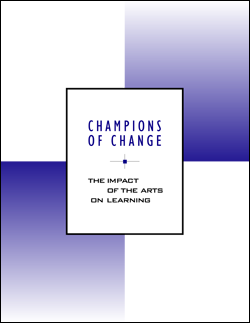Champions of Change
The Impact of the Arts on Learning
114 pages, 1999. Arts Education Partnership, One Massachusetts Avenue NW, Washington DC, 20001, (202) 326-8693, http://aep-arts.org.
Download:
![]() Champions of Change (1.4Mb)
Champions of Change (1.4Mb)
Preface
This report asserts that when young people are involved with the arts, something changes in their lives. We’ve often witnessed the rapt expressions on the faces of such young people. Advocates for the arts often use photographs of smiling faces to document the experience.
But in a society that values measurements and uses data-driven analysis to inform decisions about allocation of scarce resources, photographs of smiling faces are not enough to gain or even retain support. Such images alone will not convince skeptics or even neutral decision-makers that something exceptional is happening when and where the arts become part of the lives of young people.
Until now, we’ve known little about the nature of this change, or how to enable the change to occur. To understand these issues in more rigorous terms, we invited leading educational researchers to examine the impact of arts experiences on young people. The Champions of Change: The Impact of the Arts on Learning initiative was developed in cooperation with The Arts Education Partnership and The President’s Committee on the Arts and the Humanities to explore why and how young people were changed through their arts experiences.
We believed that evidence could be collected that would help answer the questions of why positive changes occur and what might be done to replicate them. We expected the work to build on previous research concerning the arts and learning so that similar programs could become even more effective; we also hoped to increase the overall understanding of how the arts can impact learning.
We invited the initial Champions of Change researchers to examine well-established models of arts education. We then added research efforts that looked beyond specific programs to larger issues of the arts in American education. Finally, we expanded our concept beyond classrooms and schools to include out-of-school settings. We wanted to better understand the impact of the arts on learning, not just on formal education.
The Champions of Change Researchers
For this report, seven teams of researchers examined a variety of arts education programs using diverse methodologies:
- James S. Catterall of the Imagination Project at the University of California at Los Angeles analyzed data on more than 25,000 students from the National Educational Longitudinal Survey to determine the relationship of engagement in the arts to student performance and attitudes. He also investigated the impact of intensive involvement in instrumental music and drama/theatre on student achievement.
- Shirley Brice Heath of The Carnegie Foundation for the Advancement of Teaching and Stanford University, with Adelma Roach, examined after-school programs for youth in poor communities. The researchers were interested in the qualities that made programs in the arts, sports, and community service effective sites for learning and development, and they identified features that made involvement with the arts the most powerful factor to success in and out of school.
- The Center for Arts Education Research at Teachers College, Columbia University, studied arts education programs within elementary and junior high schools. Researchers Judy Burton, Rob Horowitz, and Hal Abeles created a taxonomy of learning in the arts, and investigated the ways that learning in the arts affected learning across the curriculum and the conditions that made this possible.
- James Catterall and The North Central Regional Educational Laboratory (NCREL) evaluated the impact of the Chicago Arts Partnership in Education (CAPE). The CAPE network of nine neighborhood-based partnerships of 23 local schools, 33 arts organizations, and 11 community-based organizations has pioneered new ways to integrate the arts with learning across the curriculum.
- Researchers at the National Center for Gifted and Talented at the University of Connecticut examined the Young Talent Program and other offerings of ArtsConnection, the largest outside provider of arts education programming to the New York City public school system. They also created a model of obstacles, success factors, and outcomes for talent development in the arts.
- Steve Seidel and researchers from Harvard University’s Project Zero examined two education programs of Shakespeare & Company, a professional theatre company based in Lenox, Massachusetts. Researchers investigated the National Institute on Teaching Shakespeare, a high school teacher training program, as well as the Fall Festival of Shakespeare, an annual regional experience that involves teenagers in the study and performance of Shakespeare’s works.
- Dennie Palmer Wolf and researchers from the Performance Assessment Collaboratives for Education (PACE) of Harvard’s Graduate School of Education examined the Creating Original Opera program of The Metropolitan Opera Guild. This professional development program trains elementary and secondary school teachers in a process that enables young people to create, perform, and produce an original opera.
Report Conclusions
These Champions of Change studies demonstrate how involvement with the arts provides unparalleled opportunities for learning, enabling young people to reach for and attain higher levels of achievement. The research provides both examples and evidence of why the arts should be more widely recognized for its current and potential contributions to the improvement of American education.
Simiarly, the experiences we offer too many young people outside of school are often limited in their purpose and resulting impact. They provide recreation, but no sense of creation. They provide recess, but no sense of success. Arts learning outside of schools can also enhance the sense of accomplishment and well-being among our young people.
This research provides compelling evidence that the arts can and do serve as champions of change in learning. Yet realizing the full potential of learning in and through the arts for all American children will require heroic acts from all segments of our society. With the 21st century now upon us, we, too, must be champions of change; we must meet and exceed the challenge of giving our young people the best possible preparation we can offer them.

